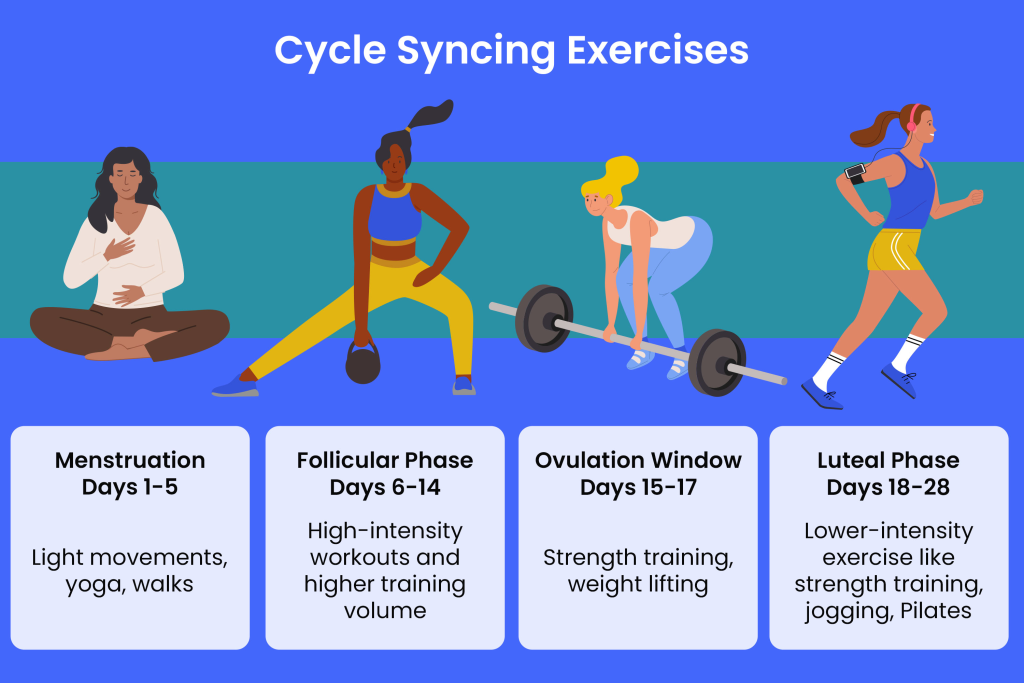
For women, hormonal fluctuations throughout the menstrual cycle can affect mood, energy levels, and physical well-being. Cycle syncing, which involves aligning various aspects of life—such as exercise, diet, and activities—with the phases of the menstrual cycle, can help mitigate stress and promote balance.
Exercises to Release Stress from the Body During Each Phase of the Menstrual Cycle:
1. Menstrual Phase (Days 1-5)
This is when you are menstruating. Your energy levels may be low, and you may feel fatigued or bloated. It’s important to focus on gentler, restorative exercises to release tension without over-exertion.
Recommended Exercises:
- Gentle Yoga: Poses like Child’s Pose, Savasana, and Legs Up the Wall help to relax and reduce lower back pain.
- Walking: A light stroll outdoors can improve circulation and ease cramps without straining the body.
- Stretching: Focus on light stretches for the back and legs, releasing tension in areas that may feel tight.
Key Benefit: These exercises support relaxation and rejuvenation, allowing the body to rest and recover while promoting blood flow.
2. Follicular Phase (Days 6-14)
The follicular phase is the period right after menstruation, leading up to ovulation. Energy levels typically begin to rise as estrogen increases, making this a good time to try more invigorating exercises.
Recommended Exercises:
- Strength Training: Moderate to intense weightlifting or bodyweight exercises, such as squats, lunges, and push-ups, can help build strength and tone muscles.
- HIIT (High-Intensity Interval Training): Quick bursts of exercise followed by rest periods can improve endurance and burn stress-relieving hormones like endorphins.
- Dance or Aerobics: Engaging in rhythmic movements releases pent-up stress and promotes a sense of freedom.
Key Benefit: These exercises align with rising energy levels, helping to boost mood, metabolism, and overall strength.
3. Ovulation Phase (Days 15-17)
During ovulation, estrogen peaks and women often feel their best in terms of energy and vitality. It’s an excellent time for exercises that are dynamic and challenging.
Recommended Exercises:
- Cardio Workouts: Running, cycling, or swimming can help release endorphins and improve cardiovascular health.
- Plyometrics: Jumping exercises like box jumps, burpees, and skipping rope increase power and help to burn excess energy.
- Group Sports: This is a great time to engage in social activities like team sports or fitness classes, which combine physical activity with a sense of community.
Key Benefit: These activities harness peak energy and optimize physical performance, reducing stress and boosting mental clarity.
4. Luteal Phase (Days 18-28)
During the luteal phase, progesterone increases, and some women may experience symptoms like bloating, mood swings, or fatigue. This is a great time to focus on calming exercises that reduce stress and promote relaxation.
Recommended Exercises:
- Pilates: Focus on core strength and stability while avoiding high-impact exercises. Pilates can help with posture and reduce stress in the lower back and abdomen.
- Gentle Yoga and Stretching: Gentle, restorative yoga practices, such as Moon Salutations, can ease tension in the body and calm the nervous system.
- Walking or Swimming: Low-impact exercises like walking in nature or swimming can help reduce bloating and ease mood swings.
Key Benefit: These exercises are designed to support relaxation and relieve any discomfort caused by hormonal changes, helping to maintain balance during this phase.
General Tips for Cycle-Syncing Exercises:
- Listen to Your Body: Every woman’s experience of her menstrual cycle is different. It’s important to adapt your workouts based on how you feel.
- Stay Hydrated and Nourished: Proper hydration and nutrition can also support stress relief and energy levels during exercise.
- Rest is Essential: Adequate sleep and rest days are just as important as exercise, especially during times when your body needs to recover.
By synchronizing exercise with your menstrual cycle, you can support hormonal health, reduce stress, and optimize physical and mental well-being.